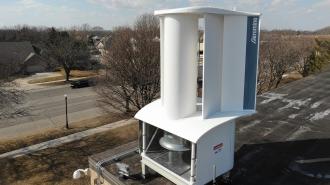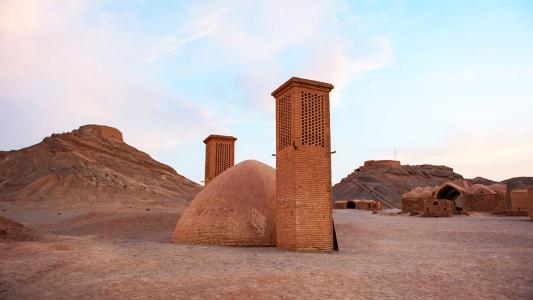A new motionless wind energy system promises to increase the amount of renewable energy generated from rooftops — helping us meet our goal of a future free of fossil fuels.
The challenge: Electricity and heat are the largest source of greenhouse gas emissions, so transitioning those sectors to renewables, such as wind and solar, is key to combating climate change, and this transition doesn’t just have to happen at the utility scale, either.
Thanks to a steady decrease in the price of solar panels, rooftop solar installations are on the rise in the US. But because the sun doesn’t always shine and batteries are expensive, most solar-powered buildings end up pulling electricity from the grid, too, continuing our dependence on fossil fuels.
Electricity and heat are the largest source of greenhouse gas emissions.
Wind turbines can generate electricity at night and in cloudy conditions, making them well suited to complement solar tech. But small turbines can’t generate much power, and large ones are better suited to open plains, hills, or the ocean than residential rooftops.
“When it comes to residential, most areas have limits of towers you can install on your house or something, so you can’t really get a turbine up very high,” Matthew Lackner, director of the University of Massachusetts’ Wind Energy Center, who wasn’t involved in the development of the new system, told Popular Science in May.
The idea: University of Houston spinoff Aeromine Technologies has developed a rooftop wind energy system that’s more compact than a typical turbine and works with wind speeds as low as 5 miles per hour — traditional small turbines require average wind speeds of at least 9 mph.
One Aeromine unit can generate as much power as an array of 16 solar panels while taking up 10% of the roof space, and when manufactured at scale, the system could generate significantly more energy than a rooftop solar installation of the same price, according to Aeromine.
How it works: Aeromine’s wind energy system doesn’t look anything like a traditional turbine — instead of spinning blades atop a thin pole, it features a motionless, tank-like cylinder flanked by airfoils.
“As the wind hits those airfoils, it creates a negative pressure that sucks the wind that’s hitting the building through an internal propeller on the bottom of the unit, which creates the energy production which connects directly to the building,” David Asarnow, Aeromine’s cofounder and CEO, told Fast Company.
Aeromine envisions 20 to 40 of these units lined up along whatever edge of a rooftop faces the direction that gets the most wind, leaving room in the center of the roof for solar panels (though the units could create too much shade depending on the direction of the sun).
“I like to think of this as kind of disruptive and complimentary [sic] to the solar business,” said Asarnow. “Our production can be stronger. At the same time, when you pair the two, you really have a path for on-site energy independence.”

Looking ahead: Aeromine’s wind energy system couldn’t be installed on slanted roofs or single-family homes, but it could make on-site wind power generation possible for warehouses, apartment buildings, or other large, flat-roofed structures.
The company has already validated its rooftop wind energy tech through joint research with Sandia National Laboratories and Texas Tech University. It is now piloting the system with several companies and expects to have a product ready for the commercial market in 2023.
We’d love to hear from you! If you have a comment about this article or if you have a tip for a future Freethink story, please email us at [email protected].






